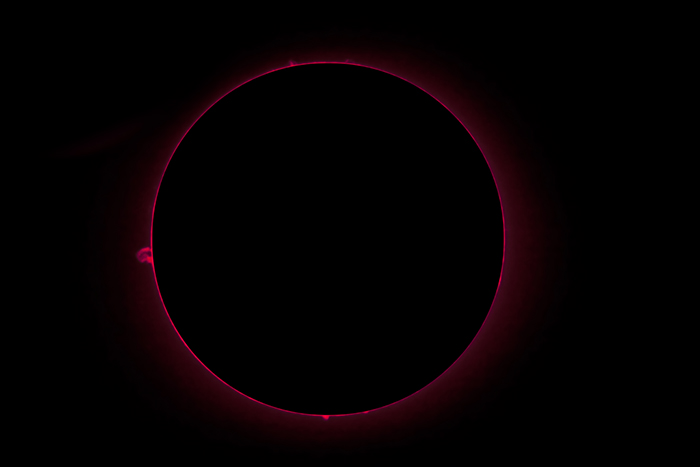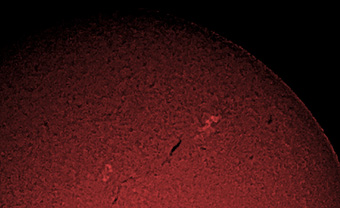|
Staring at the Sun, 2 :: home :: |
|
6/17/2010. Two rings in the sky. I found a good combination of glass and aluminum for full-disk prominence photos using the Canon 20D or 50D. That's the full frame up there showing how nicely scaled the solar image is on the APS-sized sensor. Agena Astro Products again supplied a nice piece of gear very quickly. This time it was a 1.25-inch prime focus adapter (Blue Fireball brand) and EOS T-ring (Agena also provided the new focusser and a crosshair eyepiece for my guide scope; good prices and very prompt shipping, every time). I took an Orion "Shorty" barlow apart and attached the optical elements to the end of the prime focus adapter (the adapter is threaded for such). The Hap Griffin modified 20D has about a 2 stop advantage over the 50D for this application, but the 50D's Liveview makes focussing vastly easier. So focus with the 50D, make sure everything is locked down, leave the adapter in place, and exchange bodies?
Surface detail is still tough. This outfit gives good brightness for on-disk imaging at 1/250 - 1/500 second (1/60 is better with the unmodded 50D), but contrast is abysmal, noise is bad, and what I see in the file is not nearly as pleasing as what I see in the eyepiece. Also, lots of pieces need a careful cleaning before this will work well. The double-stacked filters are overkill for prominences. I could lose the second etalon, shorten the exposure from 1/30 to 1/125 or so (or try the unmodded 50D again), and probably get better results at the limb. I also tried attaching the T-ring directly to the output side of the B600 filter / diagonal. The angle at which the camera is held when things are snugged down was unfortunate, but by backing off the threads where the B600 and the T-adapter meet, that was manageable. The Canon EOS comes that close to reaching focus in this configuration, but doesn't quite. No problem: the 1.25-inch "snout" with the barlow attached produces a much improved image scale and has plenty of room to focus. The solar image is 720 pixels wide in the close-coupled configuration and 1,775 in the barlowed arrangement. (If talk about "snouts," "barlows," and "prime focus adapters" is not second nature to you, there are pictures of these things on the next sungazing page.) Tomorrow I'll put the solar telescope on a solid equatorial mount and take my time working all this out. Pushing and tugging on the little Giro alt-az adds a level of bother gets in the way of clear thinking. Best comment I've found about this new sport is one I ran across comparing deep sky and solar photography. Paraphrasing: "At night, we work really hard to photograph things we can't see. So why is it that in the daytime we have to work just as hard to photograph things we can see?"
|
:: top ::
© 2010, David Cortner

